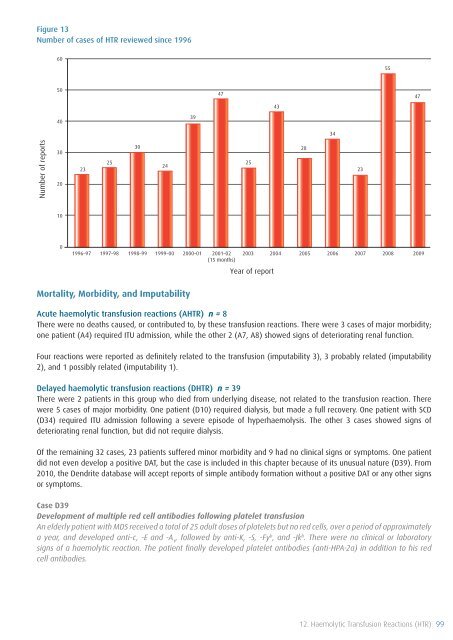SHOT Annual Report 2009 - Serious Hazards of Transfusion
SHOT Annual Report 2009 - Serious Hazards of Transfusion
SHOT Annual Report 2009 - Serious Hazards of Transfusion
You also want an ePaper? Increase the reach of your titles
YUMPU automatically turns print PDFs into web optimized ePapers that Google loves.
Figure 13<br />
Number <strong>of</strong> cases <strong>of</strong> HTR reviewed since 1996<br />
60<br />
55<br />
50<br />
47<br />
47<br />
43<br />
40<br />
39<br />
34<br />
Number <strong>of</strong> reports<br />
30<br />
20<br />
23<br />
25<br />
30<br />
24<br />
25<br />
28<br />
23<br />
10<br />
0<br />
1996–97<br />
1997–98<br />
1998–99<br />
1999–00<br />
2000–01<br />
2001–02<br />
(15 months)<br />
2003<br />
2004<br />
2005<br />
2006<br />
2007 2008 <strong>2009</strong><br />
Year <strong>of</strong> report<br />
Mortality, Morbidity, and Imputability<br />
Acute haemolytic transfusion reactions (AHTR) n = 8<br />
There were no deaths caused, or contributed to, by these transfusion reactions. There were 3 cases <strong>of</strong> major morbidity;<br />
one patient (A4) required ITU admission, while the other 2 (A7, A8) showed signs <strong>of</strong> deteriorating renal function.<br />
Four reactions were reported as definitely related to the transfusion (imputability 3), 3 probably related (imputability<br />
2), and 1 possibly related (imputability 1).<br />
Delayed haemolytic transfusion reactions (DHTR) n = 39<br />
There were 2 patients in this group who died from underlying disease, not related to the transfusion reaction. There<br />
were 5 cases <strong>of</strong> major morbidity. One patient (D10) required dialysis, but made a full recovery. One patient with SCD<br />
(D34) required ITU admission following a severe episode <strong>of</strong> hyperhaemolysis. The other 3 cases showed signs <strong>of</strong><br />
deteriorating renal function, but did not require dialysis.<br />
Of the remaining 32 cases, 23 patients suffered minor morbidity and 9 had no clinical signs or symptoms. One patient<br />
did not even develop a positive DAT, but the case is included in this chapter because <strong>of</strong> its unusual nature (D39). From<br />
2010, the Dendrite database will accept reports <strong>of</strong> simple antibody formation without a positive DAT or any other signs<br />
or symptoms.<br />
Case D39<br />
Development <strong>of</strong> multiple red cell antibodies following platelet transfusion<br />
An elderly patient with MDS received a total <strong>of</strong> 25 adult doses <strong>of</strong> platelets but no red cells, over a period <strong>of</strong> approximately<br />
a year, and developed anti-c, -E and -A 1<br />
, followed by anti-K, -S, -Fy b , and -Jk b . There were no clinical or laboratory<br />
signs <strong>of</strong> a haemolytic reaction. The patient finally developed platelet antibodies (anti-HPA-2a) in addition to his red<br />
cell antibodies.<br />
12. Haemolytic <strong>Transfusion</strong> Reactions (HTR) 99












